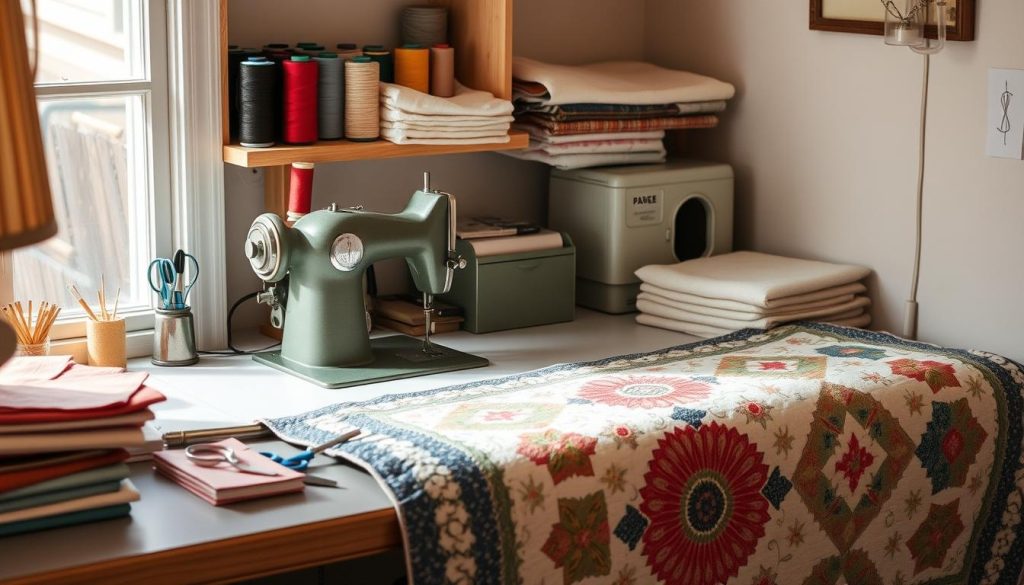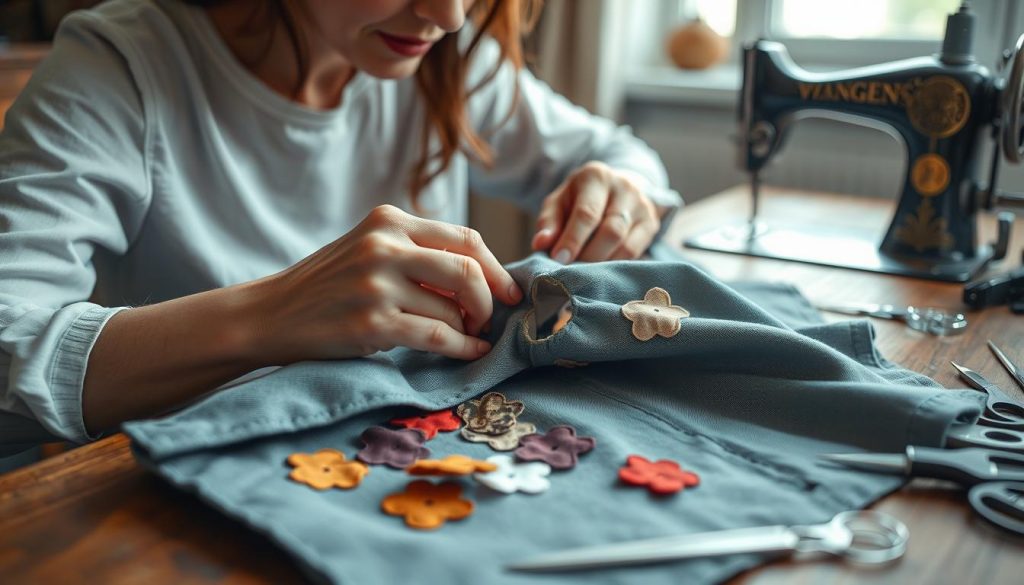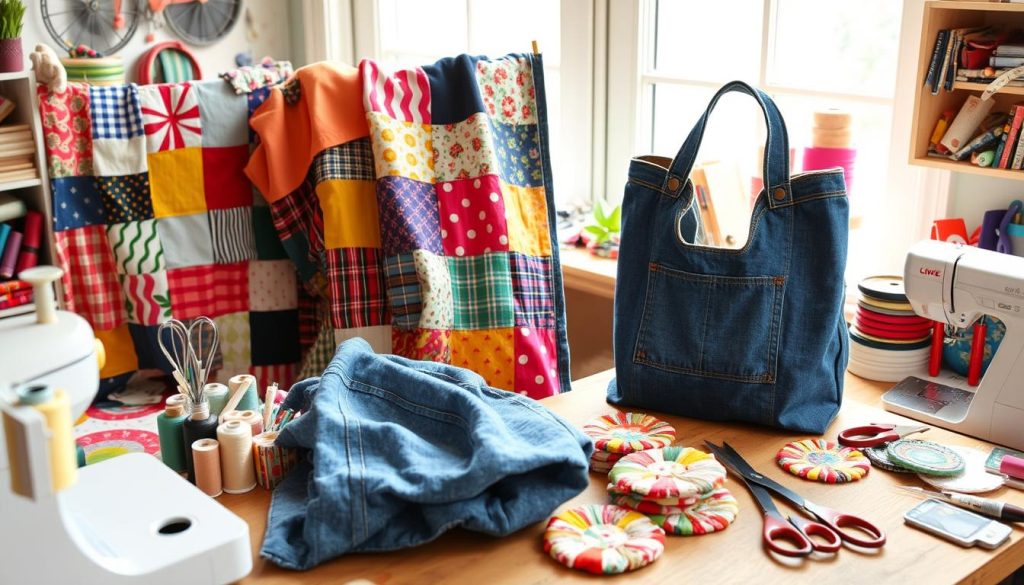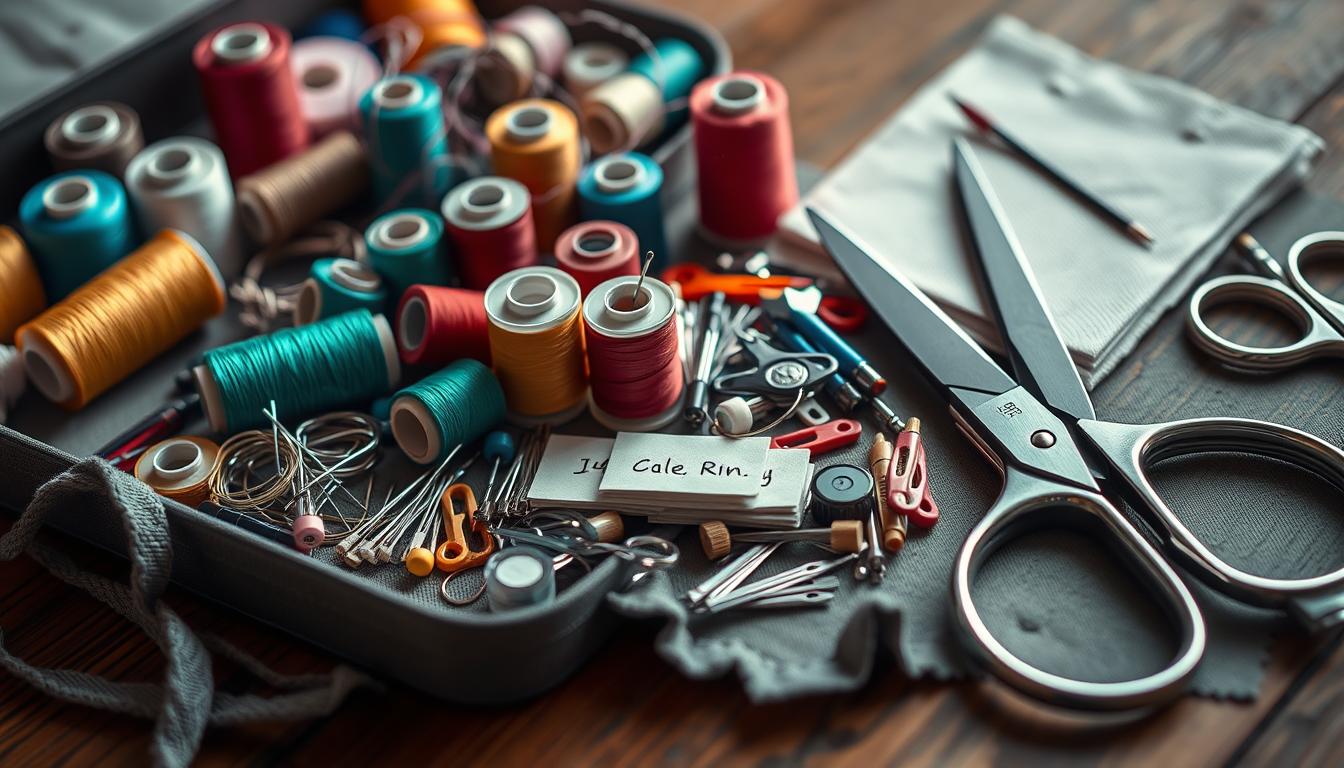Welcome to the world of sewing and repair skills! Whether you’re a seasoned tailor or just starting, these skills are key for DIY fixes. Knowing how to mend and customize your clothes is empowering. It helps you take care of your wardrobe and supports sustainability.
Learning to fix small tears and update old clothes is a big deal. It saves money and lets you show off your style. So, let’s explore how sewing and repair can change how you care for your clothes.
Introduction to Sewing and Repair Skills
Learning to sew and repair opens a world of creativity and self-reliance. You can master basic sewing and dive into detailed repair tutorials. These skills are not just practical; they also bring pride in making something by hand.
Why Everyone Should Learn These Skills
Sewing and repair skills are very useful. They help you fix clothes quickly, saving money and extending their life. They also give you the confidence to take on sewing projects, from simple repairs to making new clothes. These skills make you more sustainable and help you get the most from your wardrobe.
Benefits of Being a DIY Enthusiast
Being a DIY enthusiast through sewing and repair is very rewarding. It promotes a sustainable lifestyle by reducing waste and encouraging creative reuse. The joy of finishing a sewing project, whether it’s a simple fix or a complex design, is unmatched. These skills build confidence and spark a love for learning more.
Essential Tools for Sewing and Repairs

To master sewing and repair, you need the right tools. Quality tools improve your sewing and make repairs easier.
Must-Have Sewing Equipment
Starting your sewing journey requires essential tools. Here’s a list of must-haves:
- Sewing Machine – A sturdy, reliable sewing machine is fundamental.
- Sewing Needles – Both hand and machine needles of various sizes are essential.
- Thread – High-quality thread in multiple colors to match different fabrics.
- Scissors – Sharp fabric scissors for precise cutting.
- Measuring Tape – Accurate measurements are crucial for sewing projects.
- Pins and Pin Cushion – To hold fabrics in place while sewing.
Tools for Common Repairs
- Seam Ripper – Useful for removing stitches quickly.
- Iron and Ironing Board – Essential for pressing seams and smoothing fabrics.
- Thimble – Protects your finger when hand sewing.
- Hem Gauge – Tool for measuring hems and seam allowances precisely.
- Fabric Glue – Handy for quick fixes when stitching isn’t an option.
Organizing Your Sewing Area
Keeping your sewing area organized boosts productivity. Here are tips for a tidy workspace:
- Storage Bins – Use labeled bins for different supplies like thread, buttons, and fabric remnants.
- Drawer Organizers – Keep your tools like scissors, needles, and pins arranged neatly.
- Wall Pegboards – Hang frequently used items within easy reach.
- Lighting – Ensure your workspace is well-lit to avoid straining your eyes during intricate work.
- Cutting Table – Invest in a compact, sturdy table for pattern cutting and fabric layout.
With the right tools and a tidy workspace, you’ll improve your sewing and repair skills. This will help you offer a wide range of mending services and enhance your sewing craftsmanship.
Basic Sewing Techniques to Get Started
Starting to sew can be exciting and rewarding. It’s great for fixing old clothes or exploring new sewing projects. Learning the basics is key. This part will cover essential sewing skills, including various stitches and the differences between hand and machine sewing.
Understanding Different Stitches
Learning different stitches is the first step in sewing. Each stitch has its own use, and knowing when to use them is important. Here are some basic stitches you should learn:
- Running Stitch: Simple and common, great for beginners.
- Backstitch: Strong and secure, good for stressed areas.
- Whip Stitch: Used for hemming and finishing edges, for a clean look.
- Blind Hem Stitch: Ideal for invisible hems, essential for repairs.
Hand Sewing vs. Machine Sewing
Knowing the difference between hand and machine sewing is crucial. Each has its own benefits and uses:
| Hand Sewing | Machine Sewing |
|---|---|
| Great for detailed work and fine repairs. | Best for big projects needing speed and strength. |
| Portable, no need for electricity or big machines. | Creates consistent stitches, good for repetitive tasks. |
| More control in delicate fabrics and small areas. | Efficient for thick fabrics and long seams. |
Mastering both hand and machine sewing will make you confident in any project. Remember, practice is essential. Keep practicing with basic tutorials to improve your skills. Soon, you’ll be able to do simple repairs and complex projects with ease.
Clothing Repair Tips and Tricks

In this section, I’ll share some practical tips for fixing your clothes. You can extend the life of your favorite items using these fabric restoration techniques. From fixing holes and tears to hemming pants and skirts, and replacing buttons, these guides will help you improve your sewing and repair skills.
Fixing Holes and Tears
First, identify the fabric type and pick a matching thread. For small tears, use a simple backstitch. For bigger holes, a patch is best. Always trim loose threads before you start.
Hemming Pants and Skirts
Hemming pants and skirts is key to making your clothes look great. Start by measuring and marking the length with tailor’s chalk. Iron the seam to set it, then sew a neat hem stitch. For thick fabrics, a machine hem is best for durability.
Replacing Buttons Easily
Replacing buttons is easy with a step-by-step guide. Choose a button that matches or complements your garment. Align it with the original buttonhole and sew it in place with strong thread and a secure knot. For extra strength, add more stitches at the back of the button.
Regular fabric restoration and repairs save money and keep your clothes looking good. As you get better at these skills, you’ll feel more confident in fixing any wardrobe problem.
Creative Uses of Sewing Skills Beyond Repair

Sewing and repair skills are more than just fixing clothes. They open up a world of creativity and endless possibilities. You can do so much more than just mend tears or replace buttons.
Upcycling Old Clothes
Upcycling is a fun way to make your clothes last longer and look new. With basic sewing skills, you can turn old clothes into trendy, unique pieces. Think about making a denim skirt from old jeans or a dress from a big shirt. It’s a great way to save money and help the environment.
Creating Unique Home Décor
Why choose generic home decor when you can make something special? Use your sewing skills to make custom curtains, cushions, and table runners. These handmade items add a personal touch to your home, showing off your creativity and talent.
Gifts Made with Love
Handmade gifts are truly special. They show you care and put thought into what you give. With sewing skills, you can make unique presents like tote bags, quilts, or toys. These gifts are a heartfelt way to show you love and care.
Troubleshooting Common Sewing Issues
Dealing with sewing problems can be tough, especially for beginners. But, with the right techniques and care for your fabrics, you can solve many issues. We’ll show you how to handle tension problems and fix a jammed sewing machine.
Dealing with Tension Problems
Tension issues can ruin your sewing projects. They can cause uneven stitches, puckering, and thread breakage. Here’s how to fix them:
- Check Your Threading: Make sure the machine is threaded right. Look at the manual for the correct steps, as wrong threading often causes tension problems.
- Adjust Tension Settings: Try different tension settings on your machine. Test on scrap fabric until your stitches are even.
- Inspect the Bobbin: Ensure the bobbin is wound and inserted correctly. A bad bobbin can lead to uneven tension and poor stitching.
Fixing a Jammed Sewing Machine
A jammed sewing machine can stop your project in its tracks. Knowing how to maintain your fabrics and machines can help. Here’s how to fix a jam:
- Turn Off the Machine: Always turn off your machine before fixing it.
- Remove Fabric and Thread: Carefully take out the fabric and cut any tangled thread around the needle and bobbin.
- Check Needle Position: Make sure the needle is up before removing parts. This stops more jamming and damage.
- Clean the Bobbin Area: Take out the bobbin and clean the bobbin case. Lint and debris can jam your machine, so clean it often.
- Reassemble and Test: After cleaning, put everything back together, rethread, and test on scrap fabric. This makes sure everything works right again.
By using these techniques and keeping your machine clean, your sewing projects will go smoothly. Knowing how to solve these common problems is key to becoming good at sewing and repair.
Keeping Your Skills Sharp
Mastering sewing and repair skills is a lifelong journey. It takes dedication and a love for learning. To keep your skills sharp, use available resources, join sewing communities, and try new projects.
Resources for Continued Learning
Many resources can help you improve your sewing and repair skills. Websites like Craftsy and YouTube have lots of tutorials. Sewing magazines like Threads or Sew News also offer great tips and ideas.
It’s important to stay up-to-date with new trends and tools. This keeps your skills fresh and relevant.
Joining Local Sewing Groups
Being part of a sewing community can really help. Joining a local sewing group gives you a sense of belonging. It also lets you learn from others and get feedback.
In the United States, many places have sewing clubs or quilting guilds. These groups meet to work on projects, share techniques, and attend workshops. It’s a great way to stay motivated and inspired.
Practicing with Fun Projects
Practicing with fun projects is a great way to keep your skills sharp. Try making custom home décor, unique clothes, or handmade gifts. These projects let you use your skills in creative ways.
Remember, the more you practice, the better you’ll get. So, keep sewing, trying new things, and learning.

